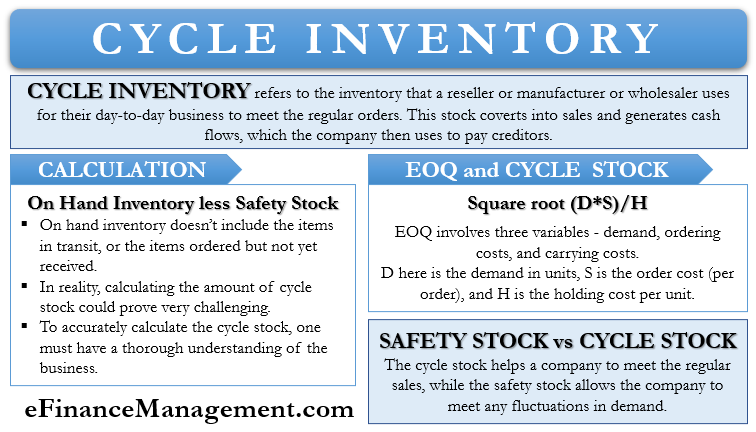Cycle Inventory or Cycle stock or working stock or lot size stock is an essential part of the total inventory. It is that part of the entire inventory that helps the company to meet the usual demand for the product. It is essential because this is what a company uses first to fulfill the customer’s order.
Or, we can say it is the inventory that a reseller, manufacturer, or wholesaler uses for their day-to-day business to meet regular orders. The cycle stock or some part of it automatically gets replaced as the company sells products. We can also say that it is the inventory that a company can sell and replenish if everything goes as per the plan.
Importance of Cycle Inventory
Cycle stock also plays an integral part in the firm’s operations. This stock converts into sales and generates cash flows, which the company then uses to pay creditors. Moreover, it is also part of the firm’s total assets on the balance sheet. A company can value the cycle stock using the LIFO (last-in, first-out) or FIFO (first-in, first-out) method. The same value then goes into the balance sheet.
Calculating Cycle Inventory
The objective of a company should be to keep the cycle stock as low as possible. It results in savings in the form of less shipping and storage costs. But, savings must not come at the cost of lost sales. Thus, a company must maintain a balance to lose sales and incur too much cost in maintaining cycle stock.
Also Read: How EOQ helps in Inventory Management?
Talking of how to calculate cycle stock, it equals to the total on-hand inventory less any safety stock. For businesses that don’t maintain safety stock, the on-hand inventory equals the cycle stock. However, this on-hand inventory doesn’t include the items in transit or the items ordered but not yet received.

In reality, calculating the amount of cycle stock could prove very challenging. It is because it involves several variables such as forecasting demand, the time it takes to get the new stock, and the inventory fill rate. Other factors are seasonality, demographics, cost of reordering, storage costs, supplier lead time, and more.
In all, to accurately calculate the cycle stock, one must have a thorough understanding of the business. A company needs to increase its cycle stock when the demand is high to prevent stockouts. Such a situation could occur when the company does not maintain adequate cycle stock or safety stock. It could prove costly as the company loses sales and clients as well.
Cycle Stock Calculation with EOQ
Many also suggest using the EOQ (Economic Order Quantity) formula to calculate the cycle stock. This formula helps to optimize the inventory by determining the stock you need and minimizes the cost per order.
Also Read: Operating Cycle Calculator
EOQ involves three variables – demand, ordering costs, and carrying costs.
EOQ Formula
√ (D*S)/H
Or
Square root (D*S)/H
D here is the demand in units, S is the order cost (per order), and H is the holding cost per unit.
Let’s consider an example to understand the calculation of cycle stock using EOQ.
Suppose Company ABC sells 1500 units of product A in a year. Its carrying cost is $5, while the cost to reorder is $150. The EOQ will be the square root of (1500*150)/5 or 300 units. It means Company ABC should maintain a cycle stock of 300 units.
Cycle Stock vs. Safety Stock
Though both cycles and safety stocks are part of the inventory, both are very different. The cycle stock helps a company to meet the regular sales, while the safety stock allows the company to meet any fluctuations in demand. Moreover, cycle stock is the inventory that a company plans to use in a specific period, but the safety stock is a buffer that a company keeps for emergencies.
Continue reading about Other Types of Inventories.
Final Words
Cycle stock is extremely crucial for a company without which it can’t survive. However, a firm must calculate this stock accurately. Higher quantum results in more costs, and a lesser quantum may lead to revenue loss. To help with the calculation, a company could deploy an inventory management system, which would provide the management with all the data it needs to accurately forecast the demand and ascertain the optimum quantity of cycle stock.
Quiz on Cycle Inventory.
This quiz will help you to take a quick test of what you have read here.


Very informative, comprehensive article. Thanks
Hi Sudip,
Thanks for sharing your experience with us.
Keep reading.
Thanks for sharing the great content here; it’s very helpful for many.